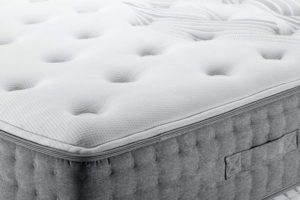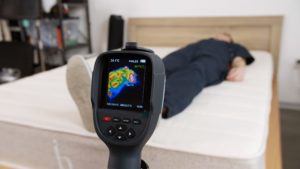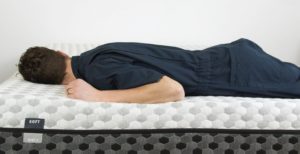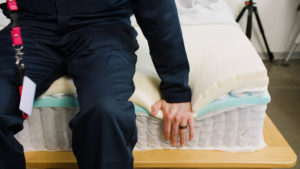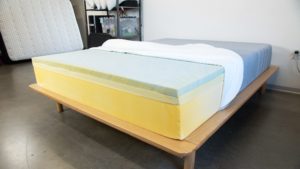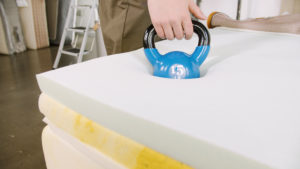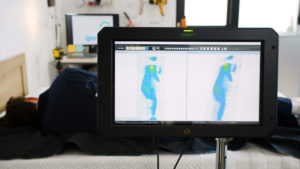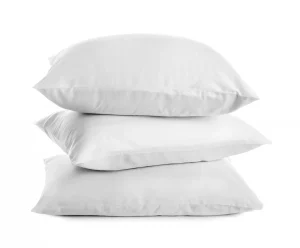Weighted Blanket Research Methodology
Weighted blankets contain plastic pellets, glass beads, and other materials to make them feel heavier than standard blankets. The idea behind weighted blankets is to provide deep compression that alleviates anxiety and helps you relax as you fall asleep. Weighted blankets sold today can range anywhere from 3 to 30 pounds. As a guiding rule, the ideal weighted blanket for any given person should be roughly equivalent to 10% of their own weight.
As with other sleep products, our team follows a detailed methodology when testing weighted blankets. We evaluate each blanket using the same performance criteria, and take additional measures to ensure objective testing conditions and results. By following strict guidelines, we can make informed recommendations to our readers. We’ll discuss our weighted blanket testing process below and explain why this methodology is so important to our hands-on evaluations.
Why You Should Trust Us
At Sleep Foundation, we take product ratings and recommendations seriously. Each member of our in-house testing team has spent years researching and evaluating sleep products. Diversity is also crucial. For our weighted blanket tests, we rely on feedback from people with different body types and personal comfort preferences.
Each weighted blanket we’ve rated and reviewed on this site has undergone our full testing process. Our team also conducts new rounds of testing throughout the year. If need be, we’ll revisit and revise our previous picks for best weighted blanket pages.
Our Weighted Blanket Research and Testing
We conduct all weighted blanket tests at our sleep lab at Sleep Doctor’s Seattle office. Our testing process consists of several stages. Many tests involve us lying beneath the blanket in different positions to evaluate temperature control and overall comfort. Some of our ratings are based on observable qualities such as ease of cleaning and material quality, and do not involve hands-on testing.
Our testers use the same mattress for each blanket to ensure objective results. During our tests, we’ll adjust the room temperature in order to evaluate blankets for both breathability and insulation. Safety is a primary concern for our team. For each blanket, we only assign testers who meet certain weight thresholds based on the “10% rule” guiding our weighted blanket recommendations.
How Do You Know a Weighted Blanket Is Right for You?
The popularity of weighted blankets has soared in recent years. That said, these blankets are not for everyone. Doctors have advised that people with circulatory issues such as asthma, low blood pressure, or type 2 diabetes should not use weighted blankets without permission from a licensed physician. Additionally, those with sleep apnea and other types of sleep-disordered breathing should not use a weighted blanket without first speaking to their doctor.
On the other hand, a weighted blanket can be beneficial for anyone who experiences stress or anxiety before sleep. The heavy compression and deep “hug” can have a relaxing, therapeutic effect that promotes sleepiness. We recommend trying out different weights to hone in on your ideal level of compression. If your local climate is exceptionally hot or humid, you should consider an open-knit weighted blanket that promotes airflow.

Weighted Blankets and Body Types
We recommend weighted blankets using the “10% rule,” which states the ideal weighted blanket for any given person weighs roughly 10% of their body weight. There is some wiggle room, though. For example, a 15-pound weighted blanket may be ideal for someone weighing 150 pounds, but could also work for any sleeper in the range of 120 to 180 pounds.
Many weighted blankets are marketed toward children. While these blankets tend to have lower weights – typically in the range of 3 to 5 pounds – you should speak to your pediatrician before investing in a weighted blanket for your child.
Weighted Blanket Feel
In addition to weight, the feel of a weighted blanket is important for ensuring comfort while you sleep. Weighted blanket inserts often have coarse exteriors, whereas the covers tend to be softer and more pleasing to the touch. Some covers are fleecy while others are smooth, and we’ve tested a few reversible weighted blankets that incorporate both of these options.
Our team has also tested some open-knit weighted blankets featuring dense yarns that supply the intended weight. In most cases, these yarns are composed of cotton, Tencel, velvet, and other fabrics that feel exceptionally soft.
Weighted Blanket Construction
Most weighted blankets consist of a weighted insert encased in a removable cover. The inserts contain glass beads, plastic pellets, or other materials to provide the intended weight. Inserts are usually quilted to evenly distribute the weighted fill, and may also contain batting for added softness and to muffle the sound of the fill shifting around as you move beneath the blanket. In most cases, the cover attaches to the insert with ties or buttons much like a duvet cover attaches to a duvet or comforter.
In recent years, open-knit weighted blankets have become popular with people who find traditional weighted blankets too hot. The open-knit construction allows air to pass through while you sleep, but the yarns are dense enough to provide sufficient weight.
Weighted Blanket Care
Keeping your weighted blanket clean is essential for maintaining a hygienic sleep environment. With traditional weighted blankets, you can remove and machine wash the cover. You may also clean the weighted insert as needed, though you should first make sure your washer and dryer can handle the extra weight. Commercial-grade appliances or a trip to your local laundromat may be necessary. It’s important to always follow the manufacturer’s care instructions as some weighted blanket inserts may be spot clean only due to their construction or bulk.
Open-knit weighted blankets tend to be more difficult to keep clean. Without a cover, you’ll need to launder the entire blanket. This may necessitate a trip to the dry cleaners or time-consuming and cumbersome hand washing. Some open-knit weighted blankets are considered machine-washable — but again, your home appliances may not be equipped to accommodate them.
Our Performance Criteria
Our hands-on weighted blanket tests consist of several different stages. We also rate weighted blankets based on observable criteria. For these performance areas, each tester assigns a numerical rating using a 5-point scale:
- 1: Poor
- 2: Fair
- 3: Good
- 4: Very Good
- 5: Excellent
Once the ratings have been assigned, we average them to generate an overall rating for each performance category. This system allows us to incorporate feedback from each tester. In the event an average score has a decimal point followed by a 5 or larger, we round up. A rating of 3.5 becomes a 4, for instance. We also round down if the decimal point is followed by a 4 or smaller.
Below, we’ll discuss each stage of our weighted blanket testing process.
Inner Fill Material
This performance area is based on a combination of observable qualities and hands-on testing. Each tester lies beneath the blanket to evaluate softness and overall comfort. We also change sleep positions and adjust the blanket to see how evenly the fill is distributed throughout the weighted insert.
Complexity of design also comes into play. We usually assign higher ratings to blankets with multiple layers of batting and weighted fill, as well as those with smaller baffle boxes. These blankets tend to feel more comfortable and distribute the fill more evenly.
Outer Shell Material
The composition of a weighted blanket’s cover is as crucial for overall performance as the inner fill. Our testers lie beneath the blanket to gauge whether the cover feels fleecy, smooth, or somewhere in between. We also consider fabric quality. For example, a cover made from a fabric more likely to pill and deteriorate quickly won’t earn as high of a rating as a cover composed of a durable material that withstands wear and tear.
For open-knit weighted blankets that don’t have covers, we’ll combine the inner fill and outer shell ratings to generate an overall score for material quality while taking the blankets’ non-traditional construction into account.
Weight Options
Our ratings for weight options are based exclusively on observable data. Blankets available in multiple weights will accommodate a wider swath of sleepers, making them more accessible to shoppers. We rate weight options using the following scale:
- 1 (Poor): The blanket is only available in one weight with a limited reach for sleepers, such as 5 or 30 pounds.
- 2 (Fair): The blanket is available in two weights. Alternatively, the blanket is available in one weight that is accessible to a wide range of sleepers, such as 15 or 20 pounds.
- 3 (Good): The blanket is available in at least two weights accessible to the majority of sleepers.
- 4 (Very Good): The blanket is available in three to four weights.
- 5 (Excellent): The blanket is available in at least five weights, including options for both adults and children.
Warmth
Since many people use blankets for warmth and insulation while they sleep, this performance area involves testing weighted blankets in relatively cold conditions. We’ll adjust the thermostat in our testing lab to simulate room temperature on a chilly night. We also use a baseline room temperature to determine whether a blanket sleeps too warm under normal sleeping conditions.
The shell textile and the fill material will both impact how warm a weighted blanket feels.
During this stage, our testers wear thermal body sensors to track temperature buildup. These sensors allow us to see if a tester feels too cold or too warm. Our testers also provide subjective observations of how warm and cozy they feel beneath the blanket.
Breathability
While warmth is an important feature for weighted blankets, some sleepers prefer a cooler covering while they sleep. We employ similar strategies to evaluate weighted blankets for testing breathability. First, we’ll adjust the lab’s thermostat to simulate conditions on a warm night. Thermal sensors indicate whether a tester feels comfortable or excessively warm, and each tester provides anecdotal observations based on their experience.
Very few weighted blankets rate well for both warmth and breathability. In most cases, a blanket either feels cozy on chilly nights but overheats in warmer conditions, or it provides decent breathability but does not offer much insulation when temperatures are low.
Durability
Evaluating a weighted blanket for durability can be challenging because there are so many factors involved in predicting how well the blanket will hold up over time. Proper care and cleaning are important factors. A blanket may be made of long-lasting materials, but improper storage or excessive laundering can still lead to early wear and tear.
Our ratings for durability are based on observable characteristics and our product expertise. In our experience, the most durable weighted blankets have open-knit designs with dense yarns that won’t deteriorate quickly. For traditional weighted blankets, we typically evaluate durability based on the outer shell since this component is more likely to be machine washed. The outer shell is also typically the part of a weighted blanket that wears down first. Fabrics like cotton, rayon derived from bamboo, and Tencel won’t wear out as quickly as polyester or microfiber.
Cleaning
Another performance category based on observable qualities, cleaning refers to the ease of keeping your weighted blanket hygienic. Most weighted blankets include at least one machine-washable component, but caring for others can be time-consuming and costly. We use the following scale to rate weighted blankets for cleaning:
- 1 (Poor): The blanket can only be dry cleaned.
- 2 (Fair): The blanket can only be hand washed or spot cleaned.
- 3 (Good): The inner blanket and/or cover can be machine washed, but separating and reassembling the blanket’s components can be a hassle.
- 4 (Very Good): The blanket’s outer cover can be machine washed, and reassembling the blanket afterward is an easy process.
- 5 (Excellent): The entire blanket can be machine washed and no separation or reassembly is required. We typically reserve this rating for open-knit blankets without covers.

